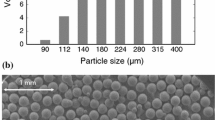Abstract
Gases may induce extensive and irreversible damage in elastomers when they are allowed to escape from the polymeric matrix. The damage is most evident as internal lacerations and also as an overall change in certain mechanical properties. The damage process, commonly termed explosive decompression failure, is really confined to gas-polymer systems which are initially equilibrated at high pneumatic stresses; greater than 107 Pa. Two interrelated facets of this phenomenon are described in the context of elastomeric composites with particular emphasis on the role of interfacial quality. The results of an optical examination of the internal cracks found during a typical gas-induced rupture cycle are described. The system is a commercial silicone elastomer-glass filler composite where the fillers have been surface modified in order to alter the adhesive strength of the interface. The data indicate that the filler particles significantly modify the stress fields in the elastomer during gas-induced rupture. Essentially, the fillers suppress the development of the characteristic large scale axially symmetrical stress fields in the composites. This visual assessment of the damage is then related to the deterioration in certain mechanical properties of this current system.
Similar content being viewed by others
References
G. K. Fleming andW. J. Koros,Macromol. 19 (1986) 2285.
M. R. Eudes et al., Nucl. Eng. 6 (1968) 586.
D. H. Ender,J. Chemtech. 16 (1986) 52.
B. J. Briscoe andD. Liatis,J. Polym. Sci. to be published.
D. Cook, paper no. 19, PRI Discussion Forum and Exhibition on “Offshore Engineering with Elastomers”, Aberdeen, Scotland, 5–6 June 1985.
A. D. Griffths, paper no. 20,ibid.
D. J. Potts, paper no. 21,ibid.
H. A. Wolcott andS. R. Straznickas, Energy Sources Technical Conference and Exhibition, ASME Petroleum Division, Dallas, Texas, 17–22 February 1985, p. 157.
G. H. Lindsey,J. Appl. Phys. 38 (1967) 4843.
A. N. Gent andD. A. Tompkins,J. Polym. Sci. A2 7 (1969) 1483.
A. N. Gent andByoungkyeu Park,J. Mater. Sci. 19 (1984) 1947.
K. Cho andA. N. Gent,ibid. 23 (1988) 141.
L. E. Lawrence,J. Macromol. Sci. A1 (1967b) 929.
G. Salomon andF. Van Bloois,J. Appl. Polym. Sci. 92 (1964) 1991.
B. J. Briscoe andS. S. Panesar,J. Phys. D 19 (1986) 841.
H. Magherefteh, PhD thesis, Imperial College (1983).
E. L. Warrick et al., Rubber. Chem. Tech. 52 (1978) 437.
A. N. Gent andP. B. Lindley,Proc. Roy. Soc. (London) A249 (1959) 195.
Author information
Authors and Affiliations
Rights and permissions
About this article
Cite this article
Briscoe, B.J., Zakaria, S. Gas-induced damage in elastomeric composites. J Mater Sci 25, 3017–3023 (1990). https://doi.org/10.1007/BF00584920
Received:
Accepted:
Issue Date:
DOI: https://doi.org/10.1007/BF00584920




